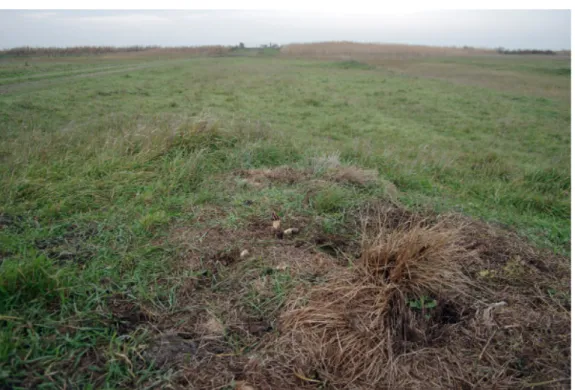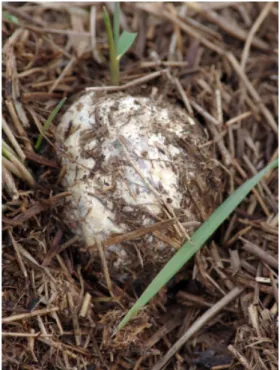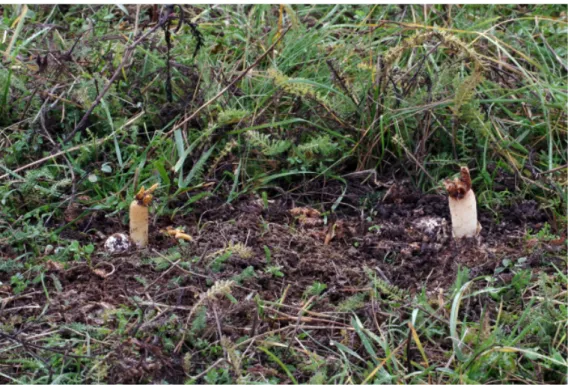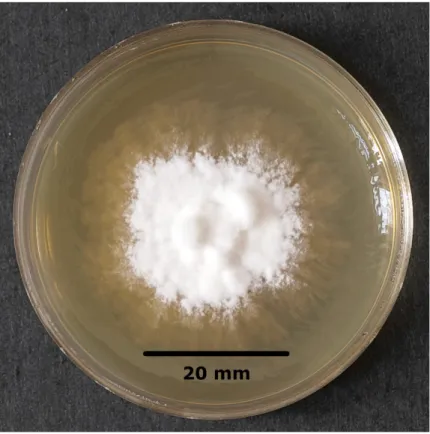LYSURUS CRUCIATUS (PHALLACEAE, FUNGI), A PHALLOID SPECIES
NEW TO THE HUNGARIAN BASIDIOMYCOTA
Csaba Locsmándi1* and Gábor Kovács 2
1*Department of Botany, Hungarian Natural History Museum,
H–1087 Budapest, Könyves Kálmán krt. 40, Hungary; locsmandi.csaba@nhmus.hu
2Hortobágy National Park Directorate, H–4024 Debrecen, Sumen u. 2, Hungary
Locsmándi, Cs. & Kovács, G. (2019): Lysurus cruciatus (Phallaceae, Fungi), a phalloid species new to the H ungarian Basidiomycota. – Studia bot. hung. 50(2): 347–356.
Abstract: Lysurus cruciatus is recorded as new to Hungary. Basidiomata of Lysurus cruciatus were detected in two localities of steppe grassland of Hortobágy, in years 2014, 2015 and 2017. Field observation, macro- and micromorphological description and taxonomic discussion of Lysurus cruciatus and a key of the stinkhorn species (Phallales) detected in Hungary are provided.
Key words: Basidiomycota, Hungary, new occurrence, Phallaceae
INTRODUCTION
Phallales E. Fisch. (Bas idiomycota) includes the mostly colourful and fas- cinating gasteroid fungi (commonly named as stinkhorns) in appearance, highly specialized in spore distribution. Basidiomata begin to develop as initially hypo- geous later semihypogeous, soft , inodorous (even if cross-sectioned) puffb all-like
“eggs” covered with a double-layered, inner gelatinous peridium which forms a basal volva at maturity. With exception of the representatives of some seques- trate (truffl e-like) genera, which remain in egg stage at development (Claustula, Gastrosporium, Gelopellis, and Protubera), mature basidiomata appear as branched or unbranched stalk bearing slimy or sticky, putrid spore mass (gleba) on their tips. Spore mass is disseminated by arthropods, especially by insects.
Spores simply stick to their feet or pass through their digestive tracks (Tuno 1998, Chen et al. 2014).
Ecology and geographical distribution of Lysurus cruciatus
Lysurus cruciatus (Lepr. et Mont.) Henn. is a terricolous, saprobic spe- cies, widely distributed in tropical and subtropical areas, known from America, Asia, Australia, and Africa. It is introduced in Europe. It has been sporadically observed and detected in several European countries (Kreisel 2001): Bulgaria
LOCSMÁNDI, CS. and KOVÁCS, G.
348
(Assyov & Gashtarov 2007), Czech Republic, France, Great Britain, Germany, Ireland, Italy, the Netherlands, Norway, Russia, Spain, Sweden. It grows soli- tary or in groups or clusters in cultivated and uncultivated soils, on plant debris, also in greenhouses in temperate regions. According to Kreisel, the fructifi ca- tion of Lysurus cruciatus is “unstable in temperate or in Mediterranean climate”
(Kr eisel 2001).
Observations in the fi eld
All basidiomata of Lysurus cruciatus were observed in the steppe grassland of the Hortobágy National Park. For the fi rst time, two basidiomata (one young specimen in egg form and another over-mature, strong-smelling specimen) were found on a loess steppe patch embedded in Artemisio-Festucetum pseudovinae community on 24 November, 2014, in the northeastern part of “Borzas-puszta”.
Th e site was partially covered with some year old, decaying hay. Almost a year later, on 11 and 17 November, 2015, in the same location (Fig. 1) some young and old basidiomata of the same species appeared (Figs 2–3).
Despite the heavy rains in October and November in the next year, no basidi- omata were found then. Until then, all the fi eld observations were exclusively car- ried out by Gábor Kovács, retired conservation ranger of the Hortobágy National Park. From 2017, Csaba Locsmándi and Gizella Vasas specialised on taxonomy of
Fig. 1. Fruiting patch of Lysurus cruciatus at Borzas-puszta, 17.11.2015 (photo: G. Kovács).
Basidiomycota in the Hungarian Natural History Museum have also been involved in further fi eld observations and investigations. Th ey performed the exact macro- and micromorphological identifi cation of the species and proposed the Hungarian name “gyertyagomba” for Lysurus cruciatus. On 24 November, 2017, two emerging basidiomata and fi ve eggs were observed in a new patch on h ighly decomposing horse manure at Máta village in A chilleo-Festucetum pseudovinae association (Fig. 4).
Morphological description
Immature basidioma (“egg”) subhypogeous, completely encased in a perid- ium; soft , globose to subglobose, obovoid, up to 40 mm in diameter; with nu- merous mycelial cords attached to the soil. Peridium whitish, consisting of two layers, rupturing to form a basal, sac-like volva with irregular lobes. Outer layer whitish, thin, membranous; inner layer translucent, thick, gelatinous.
Mature basidioma epigeous, emerging from the “egg”, composed of sterile pseudostipe and fertile apical arms. Pseudostipe 60–100 mm high, 10–25 mm wide, whitish or cream, cellular, minutely chambered, sponge-like in appearance, cylin- drical, fragile, hollow in the centre, attenuated at the base, branching at the top to form 4–7 apical arms. Receptacle arms 10–30 mm high, 5–8 mm wide (size varies
Fig. 2. Lysurus cruciatus in eg g form, at the early stage of development (photo: G. Kovács).
Fig. 3. Almost fully developed basidioma with sac-like volva and spore mass bearing relatively
short apical arms (photo: G. Kovács).
LOCSMÁNDI, CS. and KOVÁCS, G.
350
within the same specimen), short and thick, three-sided, conical, hollow, incurved initially, slightly fused at their tips, but usually free with age and remaining more or less erect. Outer surfaces whitish, concave, more or less smooth, with a longi- tudinal groove. Inner surfaces convex, transversally wrinkled, covered with olive, olive-brown, mucilaginous, gradually deliquesc ing, spore slime or gleba. Mature gleba emits a fetid odour. Disgusting to people, but attractive to many species of insects, by whom spores dispersed and carried to other locations. Basidiospores 3–4 × 1–2 μm, hyaline, elliptic to oblong, thin-walled, smooth (Fig. 5).
Fungal cultures on 2% malt extract agar isolated from the egg stage of Lysurus cruciatus are white in colour, they form a dense substrate and aerial myc- elia and show a relative slow radial growth (1 mm/day), respectively (Fig. 6).
For long-term preservation of cultures, isolates were transferred to liquid nitro- gen and deposited in the Fungal Gene tic Resource Collection at the Hungarian Natural History Museum.
Material examined: Lysurus cruciatus, Hungary, Hortobágy National Park at Máta village, in Achilleo-Festucetum pseudovinae association, on highly de- composing horse manure. Date: 24.11.2017. Leg.: G. Kovács, Cs. Locsmándi &
G. Vasas. Det.: Cs. Locsmándi. Exsiccata reference number: 109749 BP. Fungal Genetic Resource Collection reference number: 3/07201.
Fig. 4. Lysurus cruciatus basidiomata on highly decomposing horse m anu re at Máta village, in Achilleo-Festucetum pseudovinae association, 24.11.2017 (photo: G. Kovács).
Fig. 5. Lysurus cruciatus spores. Scale bar 10 μm (photo: Cs. Locsmándi).
Fig. 6. Culture of Lysurus cruciatus. Scale bar 20 mm (photo: Cs. Locsmándi).
LOCSMÁNDI, CS. and KOVÁCS, G.
352
Taxonomic discussion
Th e current genus name Lysurus was introduced by Elias Magnus Fries in Systema Mycologicum (Fries 1823) .
Facultative or heterotypic synonyms (Mycobank 2019b): Calathiscus Mont., Annales des Sciences Naturelles Botanique 16: 278 (1841); Dictyobole At- kin son, Botanical Gazette Crawfordsville 34: 42 (1902); Foetidaria A. St.-Hil., Annls Sci. Nat., Bot., sér. 2: 191 (1835); Kalchbrennera Berk., Gardeners’ Chronicle 5: 785 (1876); Kupsura Lloyd, Mycological Writings 7 (Letter 73): 1303 (1924);
Lloy dia C. H. Chow, Bull. Fan Mem. Inst. Biol., Bot.: 27 (1935); Lysurus sect.
Des ma tu rus Schltdl., Linnaea 31: 180 (1862); Lysurus sect. Schizmaturus Corda, Icones fungorum hucusque cognitorum 6: 22 (1854); Pharus Petch, Annals of the Royal Botanic Gardens Peradeniya 7 (1): 59 (1919).
Current type species of the genus is Lysurus mokusin (L.) Fr. (Fries 1823).
Lysurus cruciatus (Lepr. et Mont.) Henn., Hedwigia Beiblätter 41: 172 (1902) Basionym: Aserophallus cruciatus Lepr. et Mont., Annales des Sciences Naturelles Botanique 4: 361 (1845).
Obligate or homotypic synonym (Mycobank 2019b): Anthurus cruciatus (Lepr. et Mont.) E. Fisch. (1897).
Facultative or heterotypic synonyms (Mycobank 2019b): Anthurus borealis Burt, Memoirs of the Boston Society of Natural History 3: 504 (1894), Anthurus clarazianus Müll. Arg. (?), Anthu rus sanctae-catharinae E. Fisch. (1897), Anthurus woodii MacOwan (?), Lysurus argentinus Speg., Anales de la Sociedad Científi ca Argentina 24: 68 (1887), Lysurus australiensis Cooke et Massee, Grevillea 18 (85): 6 (1889), Lysurus borealis var. klitzingii Henn., Hedwigia Beiblätter 41:
172 (1902), Lysurus borealis var. serotinus Peck, Bulletin of the New York State Museum 157: 49 (1912), Lysurus pusillus Coker, Mycologia 37 (6): 781 (1945), Lysurus tenuis F. M. Bailey, Contr. Fl. Queens land Fungi: 306 (1911), Lysurus texensis Ellis: 30 (1880), Mutinus sulcatus Cooke et Massee (1889).
Lysurus cruciatus was fi rst described from French Guyana (capital Cayenne) in 1845 by François Mathias René Leprieur and Camille Montagne as Aserophallus cruciatus (Montagne 1845). Paul Christoph Hennings transferred it to the ge- nus Lysurus in 1902 (Hennings 1902). Lysurus cruciatus is currently accepted by the relevant and searchable taxonomic online-databases, such as Index Fungorum (Index Fungorum 2019) and Mycobank (Mycobank 2019b).
Phallales contains species mainly of tropical or subtropical origin and is represented by seven families (Clathraceae, Claustulaceae, Gastroporiaceae,
Lysuraceae, Phallaceae, Protophallaceae and Trappeaceae) supported by recent results of molecular studies (Trierveiler-Pereira et al. 2014). Lysuraceae is monotypic with only one immediately subordinate taxon Lysurus. At the present time, at least ten, generally accepted species belong to the genus (MycoBank 201 9a): Lysurus arachnoideus (E. Fischer) Trierv.-Per. et Hosaka, L. brahma gi- rii C. Mohanan, L. corallocephalus Welw. et Curr., L. cruciatus (Lepr. et Mont.) Henn., L. gardneri Berk., L. habungianus G. Gogoi et V. Parkash, L. mokusin (L.) Fr. L. pakistanicus S. H. Iqbal, Kasuya, Khalid et Niazi, L. periphragmoides (Klotzsch) Dring, and Lysurus sphaerocephalum (Schltdl.) Hern. Caff ., Urcelay, Hosaka et L. S. Domínguez (Caffot et al. 2018).
Key to stinkhorn species (Phallales) occurring in Hungary (Red list categorisa- tions are based on Rimóczi et al. 1999):
1a Basidiomata sequestrate, hypogeous, gleba not odorous, powdery at matu- rity ... Gastrosporium simplex Mattir.
Basidiomata hypogeous, oft en connected by a common rhizomorph, irregularly glo- bose, subglobose, 0.5–2 cm across, encased in a peridium. Gleba whitish at fi rst, then grey-ochre, fi nally powdery, not odorous. Spores fi nely verrucose, 3.5–5.2 × 3.5–4.5 μm, hyaline or slightly ochre in colour. On sandy steppes near Festuca, Bromus, and Stipa tussocks. Rare and endangered species. Red list catego ry: 2.
1b Basidiomata epigeous, only in egg-form, at the early stage of development subhypogeous, upper part covered with disgusting, fetid, slimy spore mass ... 2 2a Receptacle branching into tentacle-like arms ... 3 2b Receptacle unbranching ... 4 3a Pseudostipe rudimentary, arms relatively long ...
... Clathrus archeri (Berk.) Dring
Basidiomata subhypogeous at fi rst, egg-like, up to 6 cm in diameter. Th e outer layer of peridium white, pinkish, inner layer gelatinous, translucent. Ruptured peridium forming a sac-like volva at the base of the pseudostipe. Receptacle arms 3–9 cm long, lattice-like, initially joined at their tips, soon opening outward. Inner surfaces of arms bright pinkish-red, coated with traces of dark olive-coloured, putrid spore mass.
Spores 4–7.5 × 2 –2.5 μm, smooth, hyaline. Th is introduced species grows sporadically in deciduous and c oniferous woods in Hungary. Red list category: 1.
3b Pseudostipe well-developed, arms relatively short ...
... Lysurus cruciatus (Lepr. et Mont.) Henn.
(see above). Red list category: not recorded yet.
LOCSMÁNDI, CS. and KOVÁCS, G.
354
4a Spore bearing p art is cap- or thimble-like, joining to the pseudostipe at the apex. Robust species ... 5 4b Spore bearing part conical, appearing as elongation of the pseudostipe.
Receptacle entirely or partial red, pink or orange. Slender species . ... 6 5a Volva whitish ... Phallus impudicus L.
Eggs up to 6 cm ac ross, with mycelial cord. Th e outer layer of peridium white, in- ner layer gelatinous, translucent. Volva sac-like, whitish. Receptacle up to 20 cm high.
Pseudostipe whitish, hollow, fragile, sponge-like pitted, equal or tapering at both ends. Spore bearing part 3–6 cm broad, joining at the apex only, surface reticulate beneath the strong-smelling, olive-coloured spore slime. Spores 4–7.5 × 2–2.5 μm, smooth, hyaline. Widely distributed in deciduous and coni ferous woods. Red list cat- egory: not listed as endangered.
5b Volva purplish . ... Phallus hadriani Vent.
Eggs up to 5 cm acros s, with mycelial cord. Th e outer layer of peridium purplish, inner layer gelatinous, translucent. Volva sac-like. Receptacle up to 15 cm high. Pseudostipe whitish, hollow, fragile, sponge-like pitted, equal or tapering at both ends. Spore bear- ing part 2–5 cm broad, joining at the apex only, surface reticulate beneath the fetid, olive-coloured spore slime. Spores 3–4 × 1.5–2 μm, smooth, hyaline. Common on sandy soils, in woods especially in Robinieto or out of the woods, in gardens, parks.
Red list category: 4.
6a Pseudostipe 5–10 cm h igh, more or less equal longitudinally, except for the abruptly narrowing tip. Spores 3–5 × 1.5–2 μm ...
...Mutinus caninus (Huds.) Fr.
Eggs up to 2 cm broad, with mycelial cord. Peridium white, occasionally with a pink- ish tinge, with gelatinous translucent inner layer, rupturing to form a volva at the base.
Receptacle up to 10 cm high. Pseudostipe more or less equal, at most as thick as a fi n- ger, orange to pink, paler or even white toward the base, hollow, fragile, spongy. Spore mass mucilaginous, deep olive or brownish olive, coating the upper 2–3 cm portion of receptacle. Odour disgusting but not as malodorous as Phallus species. Spores 3–5
× 1.5–2 μm, smooth, hyaline. Sporadically on ground and rotten wood, in deciduous and coniferous woods. Red list category: 3.
6b Pseudostipe 9–17 cm high, from the middle, gradually tapering toward the tip. Spores 4–7 × 2–3 μm ... Mutinus elegans (Mont.) E. F isch.
Eggs up to 4 cm broad, with mycelial cord. Peridium white, occasionally with pinkish or roseate tinge. Receptacle up to 17 cm high. Pseudostipe fi nger-thick, thickest in the middle, gradually tapering toward the tip, orange to pink, paler with age and toward the base, hollow, fragile, spongy. Fetid spore mass mucilaginous, deep olive or brown- ish olive, coating the upper 2–6 cm portion of receptacle except for the very tip. Spores 4–7 × 2–3 μm, smooth, hyaline. Very rare in Hungary, on the ground, and on rotten wood. Basidiomata take a long time to develop, up to two weeks. Red list category: 3.
***
Acknowledgments – Th e authors wish to thank Gizella Vasas for her assistance in fi eldwork and for her advice and suggestions in reviewing the manuscript.
Összefoglaló: Cikkünkben a gyertyagomba (Lysurus cruciatus) első magyarországi előfor- dulásairól számolunk be, a Hortobágyi Nemzeti Park területéről, ahol két termőfolton (Borzas- puszta, ill. Máta közelében), összesen három alkalommal (2014, 2015 és 2017) találtuk, kizárólag az őszi időszakban. Ezt a szömörcsögfélék (Phallaceae) rokonsági körébe tartozó szaprotróf fajt a 20. század elején hurcolták be Európába, trópusi és szubtrópusi területekről. Kontinensünkön ma is meglehetősen ritka, csak néhány előfordulási adatát ismerjük az európai országokból. A gyer- tya gomba viszonylag hosszú tönkje leginkább az erdei szömörcsögére (Phallus impudicus) hason- lít, azonban csúcsi termőrésze nem süveg, hanem rövid, szétváló karok formájában jelenik meg, amelyeket bűzös gleba borít. Az undorítú szagú, nyálkás, bazidiospórákat tartalmazó glebát – a rokon fajokhoz hasonlóan – az ízeltlábúak, többnyire a rovarok terjesztik. A fajok közötti eliga- zodás megkönnyítése végett, a Phallales rendbe tartozó magyarországi gombafajokat határozó- kulcsba foglaltuk, és megadtuk rövid jellemzésüket is, veszélyeztetettségi besorolásukkal együtt.
A 2017 novemberében gyűjtött fi atal termőtestekből fertőzésmentes izolátum is készült, amelyet hosszú távon, élő állapotban a Magyar Természettudományi Múzeum Gombagénbankjában, fo- lyékony nitrogénben őrzünk.
REFERENCES
Assyov B & Gashtarov V. (2007): Lysurus cruciatus (Phallales) – fi rst record in Bulgaria and southeastern Europe. – Mycol. Balcan. 4: 93–94.
Caffot M. L ., Hosaka K., Domínguez L. S. & Urcelay C. (2018): Molecular and morpho- logical data validate the new combination of Lysurus sphaerocephalum from Argentina, with some additional records on Phallales (Agaricomycetes). – Mycologia 110(2): 419–433.
https://doi.o rg/10.1080/00275514.2018.1456834
Chen G., Zhang R.-R. &. Sun W.-B. (2014): Spore dispersal of fetid Lysurus mokusin by feces of mycophagous Insects. – J. Chem. Ecol. 40: 893–899.
https://doi.org/10.1007/s10886-014-0481-6
Fries E. M. (1823): Systema Mycologicum Vol. 2 . – Offi cina Berlingiana, Lund, 620 pp.
Hennings P. (1902): Eine neue norddeutsche Phal loidee (Anthurus borealis Burt var. n. klitzingii P. Hennings). – Hedwigia Beiblätter 41: 169–174.
Index Fung or um (2019): Lysurus cruciatus (Lepr. et Mont.) Henn. – http://www.speciesfungo- rum.org/Names/SynSpecies.asp?RecordID=100531 [accessed on 13.10.2019]
Kreisel H. (2001): Checklist of the gasteral and secotioid Basidiomycetes of Europe, Africa, and the Middle East. – Österr. Z. Pilzk. 10: 213–313.
Montagne C. ( 1845): Cinquième Centurie de pl antes ce llulaires exotiques nouvelles. Décades VII à X. – Ann. Sci. Nat. Botanique 4: 346–367.
Mycobank (2019a): Lysurus. – http://www.mycobank.org/Biolomics.aspx?Table=Mycobank&
Rec=96195&Fields=All [accessed on 13.10.2019]
Mycobank (2019b): Lysurus cruciatus. – http://www.mycobank.org/Biolomics.aspx?Table=Myc obank&Rec=122170&Fields=All [accessed on 13.10.2019]
LOCSMÁNDI, CS. and KOVÁCS, G.
356
Rimóczi I., Siller I., Vasas G., Albert L., Vetter J. & Bratek Z. (1999): Magyarország nagy- gombáinak javasolt Vörös Listája. (Proposed red list of macrofungi in Hungary). – Mikol.
Közlem., Clusiana 38: 107–129.
Trierveiler-Pereira L., da Silveira R. M. B. & Hosaka K. ( 2014): Multigene phylogeny of the Phallales (Phallomycetidae, Agaricomycetes) focusing on some previously unrepre- sented genera. – Mycologia 106: 904–911. https://doi.org/10.3852/13-188.
Tuno N. (1998): Spore dispersal of Dictyophora fungi (Phallaceae) by fl ies. – Ecol. Research 13:
7–15. https://doi.org/10.1046/j.1440-1 703.1998.00241.x (submitted: 13.10.2019, accepted 11.11.2019)



